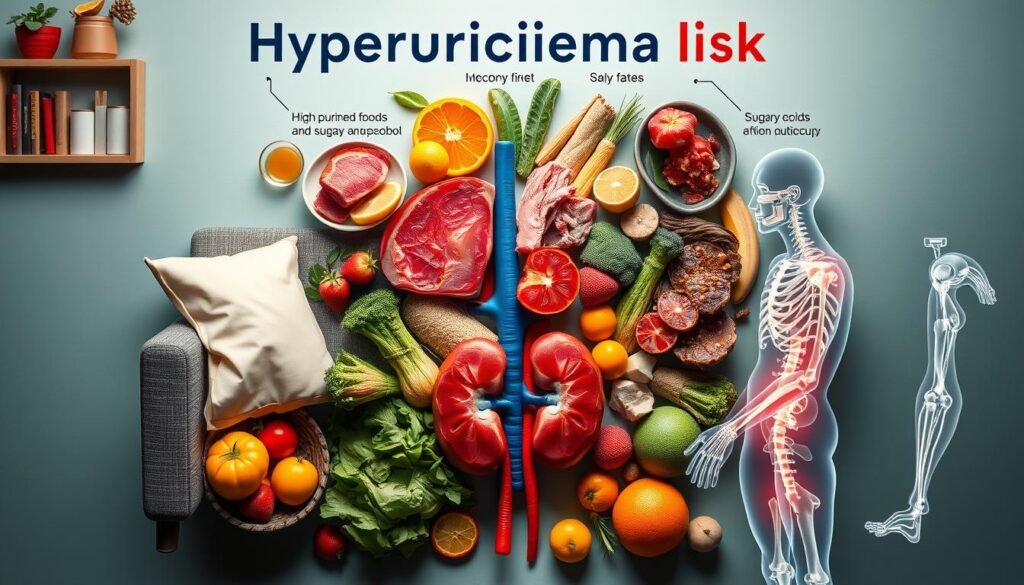Did you know that having too much uric acid in your body can harm your health? Uric acid is a byproduct of breaking down purines. It’s important, but too much can cause gout and other problems.
This guide will cover the causes, symptoms, and natural ways to manage high uric acid. We’ll look at how uric acid works in the body and what can raise your levels. You’ll learn about diet and lifestyle changes to help control uric acid and boost your health.
Key Takeaways
- High uric acid levels can lead to gout and other health issues.
- Certain medical conditions, lifestyle factors, and medications can raise uric acid levels.
- Eating foods high in purines, like red meat and seafood, can increase uric acid.
- Drinking plenty of water, eating the right foods, and managing weight can lower uric acid.
- Knowing the causes and symptoms of high uric acid is key to managing and preventing health problems.
Understanding Uric Acid and Its Role in the Body
Uric acid is a waste product from breaking down purines. Purines are found in some foods and made by our bodies. This process helps get rid of waste and keeps us healthy.
What Is Uric Acid?
Uric acid is a solid that comes from purine breakdown. It’s mainly removed by the kidneys and goes out in our urine. Keeping uric acid levels right is key for kidney function and uric acid metabolism.
Normal Uric Acid Levels
Healthy uric acid levels are between 3.5 to 7.2 milligrams per deciliter (mg/dL) in the blood. Levels can change based on gender. Men can have up to 7 mg/dL, while women top out at 6 mg/dL.
How Uric Acid Forms in the Body
Uric acid forms when we break down purines. Purines are in some foods and our body’s processes. Too many purines or trouble getting rid of uric acid can cause health problems.
“Understanding the mechanisms behind uric acid formation is crucial for managing related health conditions, such as gout and kidney stones.”
Signs and Symptoms of High Uric Acid Levels
High uric acid levels can cause painful symptoms, known as gout attacks. These attacks often hit the joints, leading to severe joint inflammation and pain.
A sudden, intense pain in the big toe joint is a common sign. The area might look red, warm, and swollen. It also might be hard to move. Gout attacks can last 1-2 weeks and might spread to other joints like the ankles, knees, and elbows.
The uric acid crystals in the joints during a gout attack can be very painful. Even the slightest touch or movement can hurt a lot. Spotting these symptoms early is key to getting treatment and stopping future attacks.
| Symptom | Description |
|---|---|
| Joint Pain | Sudden, severe pain in the big toe, ankle, or other joints |
| Joint Swelling | Significant swelling and inflammation in the affected joint |
| Joint Redness | The joint appears red and discolored due to inflammation |
| Joint Stiffness | Limited range of motion and difficulty moving the affected joint |
Spotting and managing gout attack symptoms early is crucial. It helps reduce their impact on daily life and prevents more damage to the joints.
Common Causes and Risk Factors of Hyperuricemia
Hyperuricemia is when your blood has too much uric acid. Knowing what causes it is key to managing it. This helps prevent it from getting worse.
Medical Conditions
Some health issues can lead to high uric acid levels. Kidney disease is a big risk because kidneys help control uric acid. Being obese also raises uric acid levels because of more body fat.
Hypertension, or high blood pressure, is linked to higher uric acid levels too.
Lifestyle Factors
How you live affects your uric acid levels. Drinking alcohol, especially beer and spirits, can raise uric acid. Eating too much of purine-heavy foods like red meat and seafood also increases uric acid.
Medications and Supplements
Some medicines and supplements can change uric acid levels. Diuretics used for high blood pressure can increase uric acid. Some pain relievers, like aspirin, can also affect uric acid levels.
Knowing these causes and risks helps you take steps to control uric acid. This can lower your chance of hyperuricemia and related health problems.

Diet and Lifestyle Modifications for Managing Uric Acid
Keeping a low-purine diet is key to managing uric acid levels. It helps prevent gout attacks. Eating less of foods high in purines, like red meat and some seafood, can help. Also, drinking more water helps get rid of uric acid.
Being at a healthy weight is also important. Studies show that losing weight can lower uric acid levels. This can also make gout attacks less frequent.
- Avoid high-purine foods like red meat, organ meats, and certain seafood (e.g., anchovies, shellfish, sardines, and tuna).
- Consume more low-purine vegetables, such as asparagus and spinach, which do not increase the risk of gout or recurring attacks.
- Drink coffee in moderation, as it may be associated with a reduced risk of gout attacks.
By making these diet and lifestyle modifications, people with high uric acid levels or gout can manage their condition better. This can help reduce the risk of painful flare-ups.
“Seven randomized controlled trials were included in the review regarding the clinical and cost-effectiveness of diet and lifestyle modifications for gout.”

The quality of evidence from the studies varied. Some had very low-quality evidence due to bias and imprecision. Yet, the findings suggest that diet changes, more hydration, and weight management can help manage uric acid levels. This can improve life quality for those with gout.
Natural Solutions and Remedies
Medical treatments can help manage uric acid levels. But, natural solutions and remedies can also be helpful. Adding these natural approaches to your life can ease gout symptoms and lower the chance of future attacks.
Hydration and Water Intake
Drinking enough water is key to getting rid of excess uric acid. Aim for at least 8 cups (64 ounces) of water a day. This can help reduce swelling and inflammation from gout. Also, mixing two lemons’ juice into 2 liters of water daily can lower uric acid levels.
Beneficial Foods and Supplements
Some foods and supplements can help manage uric acid levels. Cherries and tart cherry juice are full of anti-inflammatory compounds called anthocyanins. They can lower blood uric acid levels. Apples, being high in fiber, can absorb uric acid from the blood, helping to get rid of it.
Vitamin C supplements can also help reduce uric acid. Herbs like hibiscus, dandelion, and ginger have shown to lower uric acid levels too.
Exercise and Weight Management
Keeping a healthy weight and exercising regularly are key to managing uric acid levels and preventing gout. Being overweight can lead to gout because it increases uric acid production. Activities like walking, swimming, or low-impact exercises can help keep uric acid levels in check and reduce gout flare-ups.
By using these natural solutions and remedies, along with medical treatments, people with high uric acid levels or gout can manage their condition better. This approach can improve their overall health and well-being.
Conclusion
Keeping uric acid levels healthy is key for good health and avoiding gout and kidney stones. By making diet changes, lifestyle tweaks, and sometimes medical help, Australians can manage uric acid well. This helps lower the risk of health problems.
Checking uric acid levels often, eating a low-purine diet, drinking plenty of water, and exercising regularly are important. Natural remedies can also help. But, it’s vital to talk to doctors, especially if you have gout often or high uric acid levels.
By changing your lifestyle and getting professional advice, Australians can keep uric acid levels healthy. This helps prevent gout and boosts overall health. With the right steps, people can manage uric acid and live a better life.










